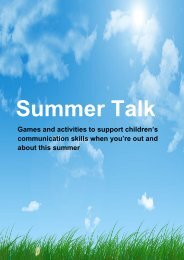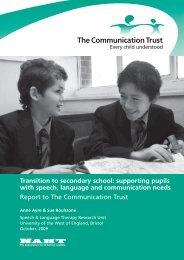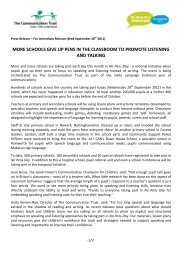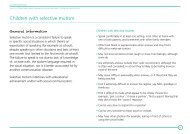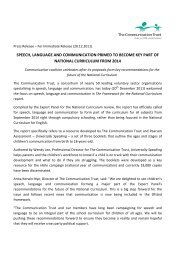Communicating Phonics - The Communication Trust
Communicating Phonics - The Communication Trust
Communicating Phonics - The Communication Trust
Create successful ePaper yourself
Turn your PDF publications into a flip-book with our unique Google optimized e-Paper software.
<strong>Communicating</strong> <strong>Phonics</strong>Section 4 > Different types of speech, language and communication needs > Children with phonological delay/disorderChildren with phonological delay/disorderAlso known as speech delay or disorderGeneral informationA child with a phonological delay/disorder hasdifficulty producing speech.Phonological delay/disorder:• Affects the child’s sound system meaning their speech isunclear and difficult to follow• Isn’t primarily caused by physical disabilities• Is often part of language delay/disorder/impairment but mayoccur as a standalone difficultyChildren with phonological difficulties are likely to havedifficulties with all aspects of phonological awareness includingdiscriminating between sounds, holding several sounds intheir short-term memories and blending sounds. Both real andpseudo words will be affected.Phonological delay is used when a child has patterns of speechwhich are more typical of a younger child. <strong>The</strong> sound system isdeveloping normally, but at a much slower rate than expected.Phonological disorder will involve some delay, but also the useof phonological processes that are atypical, inconsistent or notfollowing the expected pattern of phonological development.This is likely to make the child less clear, will be more persistentand require specialist support.Helping to access the phonics screening checkChildren with phonological difficulties are likely to find it very hardaccessing the check because they haven’t mastered the phonologicalskills required for speech development, and these are the same as thoserequired for learning literacy. It may be appropriate for some childrenwith significant phonological difficulties to be disapplied from the check.Possible issuesIf a child makes errors it willbe almost impossible to tellwhether these are due to themnot knowing the phonemeassociated with the grapheme, orbeing unable to actually say thephonemeChildren with phonologicaldifficulties may need more time toprocess and produce their responsesChildren are likely to havedifficulty with non-wordsWays to helpSeek information from a speech andlanguage therapist to understand thespecific difficulties a child hasIt might be necessary to use alternativestrategies to check phoneme-graphemecorrespondence, for example:• Identifying single graphemes bysigning or gesture (for example, JollyPhonic action, Cued Articulation sign)• Compiling a list of simple words thatare within the child’s sound system touse as a screen<strong>The</strong>re should be no time constrainton them completing the check<strong>The</strong>y will need extra tuition in thisarea36




